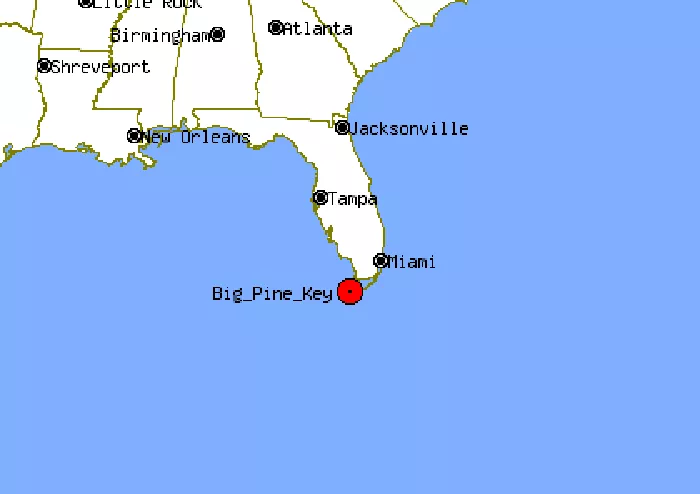Big Pine Key is a serene island situated in the Lower Florida Keys, approximately 100 miles southwest of Miami and 30 miles northeast of Key West. As part of Monroe County, Florida, it lies along the Overseas Highway (U.S. Route 1), between mile markers 29.5 and 33. The island is renowned for its natural beauty, wildlife refuges, and a relaxed, small-town atmosphere.
Geographical Overview
Location and Accessibility
- Coordinates: 24.6861° N latitude, 81.3611° W longitude.
- Area: Approximately 10.3 square miles (26.7 km²), with 0.1 square miles (0.28 km²) covered by water.
- Elevation: Around 3 feet (1 meter) above sea level.
- Transportation: Accessible via U.S. Route 1, also known as the Overseas Highway, which connects the Florida Keys. The highway runs along the eastern edge of Big Pine Key, providing direct routes to nearby islands and the mainland.
Nearby Islands and Landmarks
- No Name Key: Located to the northeast, accessible via a short bridge.
- Bahia Honda Key: Situated to the west, home to Bahia Honda State Park, known for its beaches and snorkeling opportunities.
- Key West: Approximately 29 miles southwest, offering a range of cultural and recreational activities.
Cultural and Community Aspects
Demographics
As of the 2020 census, Big Pine Key had a population of 4,521 residents. The community is characterized by a mix of long-term residents and seasonal visitors, contributing to a diverse cultural landscape.
Local Economy and Lifestyle
The island’s economy is primarily driven by tourism, fishing, and small businesses. Local establishments include seafood restaurants, art galleries, and shops catering to both residents and visitors. The community values environmental conservation, with many initiatives aimed at preserving the island’s natural habitats.
Ecological Significance
National Key Deer Refuge
Big Pine Key is home to the National Key Deer Refuge, established in 1957 to protect the endangered Key deer, a subspecies of the white-tailed deer. The refuge spans approximately 8,542 acres, encompassing upland forests, wetlands, and marshes. It provides habitat for over 20 other threatened and endangered species.
Blue Hole
The Blue Hole is a former limestone quarry that has become the only freshwater lake in the Florida Keys. It serves as a vital water source for local wildlife, including alligators, turtles, and various bird species. The site is a popular destination for nature enthusiasts and photographers.
Recreational Opportunities
Outdoor Activities
- Hiking and Wildlife Viewing: Trails within the National Key Deer Refuge offer opportunities to observe diverse flora and fauna.
- Water Sports: The surrounding waters are ideal for kayaking, paddleboarding, and snorkeling.
- Fishing: Both offshore and backcountry fishing are popular, with various charter services available.
Bahia Honda State Park
Located nearby on Bahia Honda Key, this state park features pristine beaches, clear waters, and excellent snorkeling spots. The park also offers camping facilities and nature trails.
Environmental Challenges and Conservation Efforts
Climate Change Impact
Rising sea levels pose a significant threat to Big Pine Key’s ecosystems, particularly the habitats of the Key deer and other wildlife. Saltwater intrusion affects freshwater resources, and increased flooding risks challenge both natural and human communities.
Conservation Initiatives
Efforts to mitigate environmental impacts include habitat restoration projects, public education campaigns, and infrastructure adaptations such as wildlife underpasses to reduce vehicle collisions with Key deer. Local organizations and government agencies collaborate to promote sustainable practices and preserve the island’s ecological integrity.
Conclusion
Big Pine Key stands out as a unique destination that combines natural beauty, ecological importance, and a close-knit community atmosphere. Its location within the Florida Keys offers both tranquility and accessibility, making it an appealing spot for visitors seeking outdoor adventures and a connection with nature. Ongoing conservation efforts aim to ensure that Big Pine Key remains a haven for wildlife and a cherished locale for future generations.

